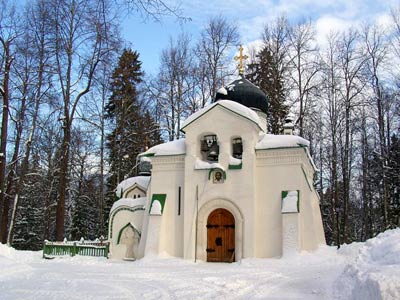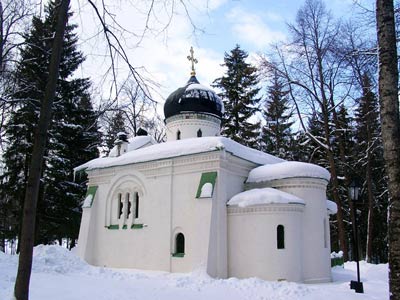CHURCH OF THE SAVIORÂ
"It was on Holy Saturday in 1880 when the Vorya River flooded and people from nearby villages had no opportunity to cross the river and attend the Easter service in the church, they directed their steps to the estate because they knew that the matins would be held there. The Abramtsevo manor house was full of worshippers and Savva Mamontov got the idea to correct the situation and to build a separate chapel... But the idea did not come true, – recalled Natalya Polenova, the participant of the Abramtsevo Colony. – In 1881 the spring was wonderful, the matins were organized in the Manor House and then the idea was brought up again. But everybody decided that a chapel would be too small and that it would be better to build a church. We chose the appropriate place in the park and were determined to build a church in the name of the Icon of Christ of Edessa, on the model of Old Russian cathedrals". The basic project for the church was worked out by Vasily Polenov and the prototype for it became the Church of the Saviour at Nereditsa (12th century) located near Novgorod. This project outlined the main proportions and forms of the future building. The dome reposed on the massive drum crowing the high pyramidal roof. The portal of the main façade with the Icon of Christ of Edessa had the look of a belfry. Three apses were at the eastern sanctuary part. For the northern façade the artist designed two windows: the triple one and the small semi-oval window. The walls were strengthened with buttresses. The main difficulty was the southern façade. Well observed through the alley of the park it was as important as the western one. Vasily Polenov left the project unfinished. Viktor Vasnetsov continued the work at the project. "I was keen on the Kremlin and Moscow churches, later on the Yaroslavl and Rostov ones", – he wrote in his letter to Vladimir Stasov. The artist changed the proportions, made the walls higher and the roof lower. The two windows of the northern façade were shifted to the southern one thus making it impressive and letting more light into the church. The Vasnetsov's church became proportional and harmonious, it better corresponded to its purpose – to be a small estate church, nestled in the Abramtsevo park. Â
In 1881 Viktor Vasnetsov wrote about the beginning of the construction: "All of us, the artists – Vasily Polenov, Ilya Repin, me – Savva Mamontov and his family set to work together being inspired. Our art assistants – Yelizaveta Mamontova... Yelena Polenova, Natalya Polenova (she was Yakunchikova then), Vera Repina – kept up with us. We were drawing facades and ornaments, painting icons and our ladies were embroidering gonfalons, veils and cloths, they were even carving ornaments in stone standing on the scaffold like real stonemasons. Savva Mamontov was working as a sculptor... There was so much energy and art creativity: everybody was working tirelessly, competing and with interest..." By the end of July the church was roofed. Decorative work and interior required the detailed studying of the medieval Russian art and participants of the Colony took trips to Rostov, Yaroslavl and other towns. In summer the church was adorned with stone carved ornaments. The ornament of the portal roller had images connected with Christian symbols and Gospel themes: the Lamb personified Christ; the head of a donkey reminded the Christ's entry into Jerusalem; the cock – the denial of the Apostle Peter; the angel, lion, eagle and calf symbolized evangelists and the like. The frieze of coloured tiles made the massive drum more elegant. Later the Icon of Christ of Edessa painted by Vasily Polenov was placed above the portal (1882) and the chimney was covered with tiles (1890s). The leading role in the interior design was given to Vasily Polenov. His sketches were used to make the iconostasis, icon cases, candleholders, the altarpiece cross, the church chandelier, wedding crowns, gonfalons and other church utensils. The double-level iconostasis dates back to the interiors of the rural churches in the Russian North. Icons of traditional painting collected by the Abramtsevo Colony participants are combined with the authors' icons: "Christ of Edessa" by Ilya Repin (1881–1882), "St. Nicholas" by Nikolay Nevrev (1881), "St. Sergius of Radonezh" and "Virgin and Child" (1881) by Viktor Vasnetsov (1882), "Annunciation" by Vasily Polenov (1882) and other works of the Abramtsevo artists. It was the first time when the icons of the Orthodox Church were painted in realistic manner, anticipating the work of Viktor Vasnetsov in the St. Vladimir's Cathedral of Kiev. The relief "The Head of John the Baptist" on the northern wall was made by Mark Antokolsky (1880s), the icon on the southern wall "St. Prince Fyodor with his Sons Konstantin and David" was painted by Yelena Polenova (1890s). Viktor Vasnetsov painted flowers and butterflies on the choirs. He was also the author of the mosaic floor with a stylized flower and the dates of the construction: 1881–1882 written in Slavonic letters. In 1892 Mikhail Vrubel designed the stove. Preparation of documents took all summer in 1881. In autumn, when the church was already built, the official laying was held, and the next summer the church was consecrated in the name of the Icon of Christ of Edessa. Â
As opposed to the buildings of eclecticism, the Abramtsevo church is carefully stylized as an Old Russian one; it combines the elements of different architectural schools. It is the first masterpiece of the Art Nouveau style in Russia that got the development in "Hut on Chicken Legs" (1883) and the designs for the performance "Snow Maiden" (1880s) made by Viktor Vasnetsov. After the death of Mamontov's son Andrey, in 1891, the vestry where he had been buried was rebuilt into a chapel (1891–1892) under the project of Viktor Vasnetsov. As compared with the church it is decorated with multicolor tiles of floral pattern and fanciful painting of the dome which makes a refined impression. Later on the Mamontovs' daughter Vera (1907), Yelizaveta Mamontova (1908), her grandson Sergey (1913) and Savva Mamontov (1918) were buried near the church. Nowadays divine services are held in the church on memorable days. .
View the embedded image gallery online at:
http://abramtsevo.net/eng/guidway/saviors-church.html#sigProGalleriae6e6c29a3c |




